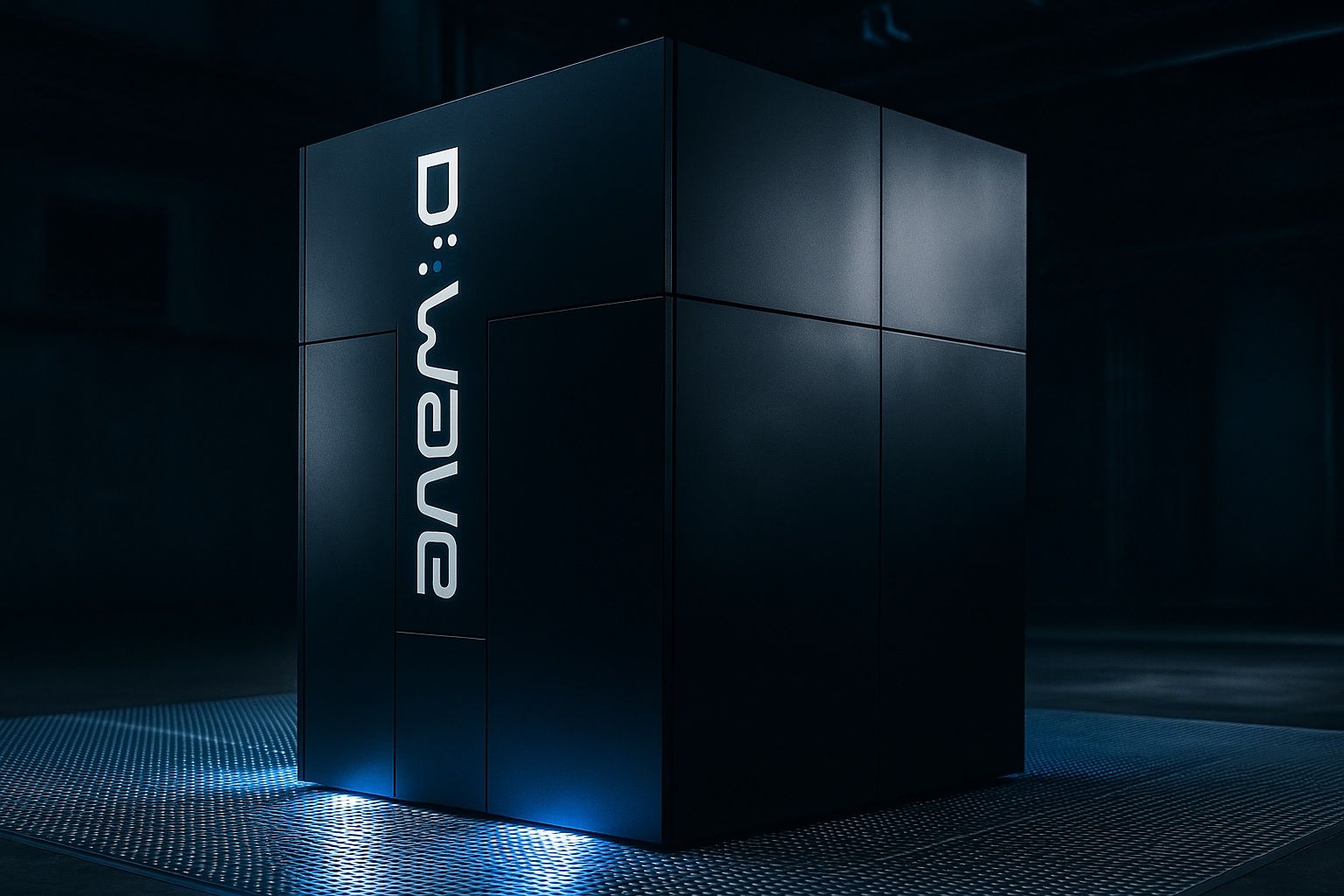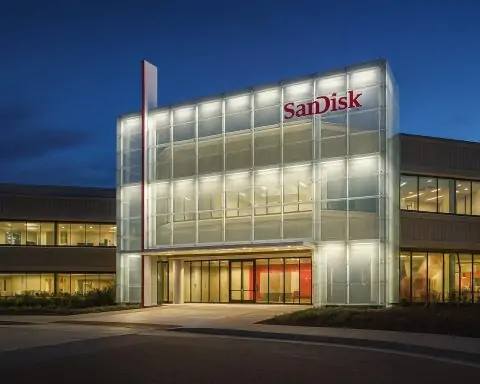Updated: November 16, 2025
Key Takeaways
- QBTS is trading around $23.61, valuing D‑Wave Quantum at roughly $8.2 billion, down about 20% this week but still up more than 1,300% over the last 12 months. [1]
- The stock’s 52‑week range is $1.42–$46.75, meaning shares currently sit about 50% below their October highs but massively above their 2024 lows. [2]
- November 2025 catalysts include Q3 earnings with 100% year‑over‑year revenue growth, a new U.S. government deployment, a completed BASF proof‑of‑concept, an aggressive public‑warrant redemption, rising analyst price targets and fresh institutional buying. [3]
- Wall Street remains broadly bullish: analysts rate QBTS “Strong Buy” with a 12‑month average price target around $27–28, implying mid‑teens percentage upside from current levels, but targets range widely from about $12 to over $40. [4]
- Under the surface, fundamentals remain early‑stage: trailing‑12‑month revenue is about $24 million against an $8+ billion valuation, heavy net losses and meaningful dilution from warrant exercises. [5]
QBTS Stock Today: Price, Market Cap and Volatility
As of the latest trading data ahead of this update (close on November 14–15, 2025), D‑Wave Quantum Inc. (NYSE: QBTS) last changed hands at about $23.61 per share. That gives the quantum‑computing specialist a market capitalization of approximately $8.2 billion. [6]
Key trading stats:
- Day range (most recent session): roughly $21.5–$25.0 [7]
- 52‑week range: about $1.42–$46.75 [8]
- 1‑year price change: roughly +1,300–1,400%, making QBTS one of 2025’s most explosive quantum‑computing names. [9]
- Average daily volume: just over 50 million shares, underlining how heavily traded and momentum‑driven this stock has become. [10]
Despite the huge 12‑month rally, QuiverQuant and Fintel data show QBTS fell about 20% this week, as traders digested earnings, analyst revisions and the warrant‑redemption news. [11]
November 2025 News Round‑Up: What’s Moving QBTS Now
November has been packed with company‑specific headlines for D‑Wave Quantum. Here’s a structured walkthrough of the most important ones investors are trading on.
1. Q3 2025 Earnings: Revenue Doubles, Losses Driven by Warrants
On November 6, 2025, D‑Wave reported Q3 FY2025 results: [12]
- Revenue: $3.7 million, up 100% year‑over‑year (from about $1.9 million) and ahead of the roughly $3.0 million consensus.
- Bookings: $2.4 million for the quarter, up modestly year‑over‑year but up ~80% sequentially from Q2’s $1.3 million, signalling accelerating customer demand. [13]
- GAAP gross margin: ~71%, a sharp improvement versus the mid‑50s a year ago, helped by higher‑margin system sales and Advantage2 upgrades. [14]
- Net loss: $140 million, or $0.41 per share, versus a $22.7 million loss a year earlier. The bulk of the increase came from non‑cash, non‑operating charges tied to warrant remeasurement and warrant‑exercise losses, rather than operating performance. [15]
- Adjusted net loss: about $18.1 million, or $0.05 per share, narrower than last year’s $23.2 million ($0.12 per share). [16]
For the first nine months of 2025, D‑Wave generated revenue of $21.8 million, up roughly 235% year‑over‑year, but also recorded a GAAP net loss of about $312.7 million, again heavily influenced by non‑cash warrant‑related items. [17]
The company ended Q3 with a record consolidated cash balance of around $304 million, according to its investor‑relations disclosures, giving it a substantial—though not unlimited—funding buffer to pursue growth. [18]
Market reaction was volatile: some coverage highlighted the beat on revenue and the ramp in bookings, while others emphasized the ongoing heavy cash burn and dilution risk, leading to sharp swings in QBTS in the days following the print. [19]
2. U.S. Government & Defense: Advantage2 for National Security Work
On November 3–4, 2025, D‑Wave announced that its Advantage2 annealing quantum computer is now available for U.S. government work through Davidson Technologies in Huntsville, Alabama. [20]
- The system is positioned to tackle “mission‑critical government problems” and optimization tasks that are increasingly difficult for classical supercomputers.
- Federal customers can access D‑Wave’s machine via Davidson’s infrastructure, expanding D‑Wave’s footprint in defense and national‑security workloads.
For a tiny revenue base, landing a visible defense‑sector deployment is strategically important: it strengthens the bull‑case narrative that D‑Wave’s annealing technology is moving from R&D experiments into real‑world, high‑value use cases.
3. Industrial Use Case: BASF Manufacturing Proof‑of‑Concept
Also in early November, D‑Wave and BASF announced completion of a proof‑of‑concept project using a hybrid quantum application to optimize workflows at a BASF liquid‑filling facility. [21]
According to the SEC filing and company press release, the quantum‑enhanced solution reduced the time needed to generate production schedules from hours to seconds, showcasing a concrete industrial benefit of D‑Wave’s approach to optimization. [22]
While the project is still a pilot, not a full commercial roll‑out, it supports the investment thesis that quantum annealing can deliver measurable efficiency gains in complex manufacturing environments—an important datapoint for future enterprise deals.
4. Public‑Warrant Redemption and Capital Structure Shake‑Up
On October 20, 2025, D‑Wave announced it would redeem all outstanding public warrants to purchase its common stock, with a redemption date of November 19, 2025, at $0.01 per warrant. [23]
On November 13, the company issued a reminder press release:
- Warrant holders have until 5:00 p.m. New York time on November 19, 2025 to exercise their warrants.
- The company expects November 17 to be the last day the warrants trade on the NYSE. [24]
This move has several implications for QBTS:
- Short‑term: volatility, as traders game the warrant exercises, hedging and arbitrage around the redemption.
- Medium‑term: potential share‑count increase from exercised warrants, offset by the cash inflow to D‑Wave’s balance sheet. The company has already raised tens of millions this year via warrant exercises. [25]
- Long‑term: removing the public warrants could reduce a structural overhang and simplify the capital structure, but it also underscores how dependent D‑Wave still is on equity‑linked financing.
5. Analyst Upgrades and Contract Commentary
Brokerage research has turned notably more optimistic in early November:
- Benchmark recently raised its QBTS target from $20 to $35 and reiterated a Buy rating, citing D‑Wave’s contract pipeline and the potential for its deals to be worth “millions of dollars” each over time. [26]
- Other firms, including Canaccord Genuity, Rosenblatt, Cantor Fitzgerald, B. Riley and Piper Sandler, now have targets between roughly $13 and $41, with most skewed to the upper half of that range. [27]
- Across 11–12 covering analysts, consensus is “Strong Buy,” with an average 12‑month target around $27–28 and some third‑party aggregators showing longer‑term medians near $35–38. [28]
In other words, Wall Street’s published expectations are bullish, but the spread between the lowest and highest targets is wide—consistent with how uncertain and speculative the business still is.
6. Short Interest, Short‑Seller Scrutiny and Contrarian Views
Despite strong price momentum, short interest in QBTS remains elevated:
- As of October 31, 2025, about 43.3 million shares were sold short, roughly 12–13% of the public float, with a short‑interest ratio of around 0.7 days to cover. [29]
Recently, well‑known short‑seller Andrew Left (Citron Research) disclosed bearish positions in both Rigetti Computing (RGTI) and D‑Wave Quantum, warning that some quantum names may be overhyped relative to their commercial traction and R&D costs. [30]
Meanwhile, a widely shared opinion piece on Yahoo argued that quantum‑computing stocks like IonQ, Rigetti and D‑Wave could fall 50% or more by 2026 if expectations reset. [31]
And a Nasdaq column highlighted that, at an $11 billion‑ish valuation, D‑Wave would eventually need around $1.8 billion in annual revenue at healthy profit margins to justify the price on traditional metrics—far above today’s roughly $22–24 million trailing revenue. [32]
These voices capture a key theme: the bull story is powerful, but so is the skepticism.
7. Fresh Institutional Buying
On November 16, 2025, MarketBeat flagged that SG Americas Securities LLC opened a new position of about 980,000 QBTS shares, valued around $14.3 million, representing approximately 0.34% of the company at the time of the filing. [33]
While a single position does not make a trend, it reinforces the idea that institutional investors are still willing to take sizable, speculative stakes in D‑Wave despite volatility and rich valuations.
Technology and Strategic Context: Why QBTS Has Exploded Higher
D‑Wave is not a generic “AI” name riding hype; it’s a vertically focused quantum‑computing company with a distinctive technology stack:
- It has spent more than 25 years and over half a billion dollars developing quantum annealers, optimized for combinatorial optimization problems. [34]
- In 2025, D‑Wave published peer‑reviewed work showing its system solving a materials‑simulation problem in minutes that could take classical supercomputers far longer—an achievement some journalists labeled “quantum supremacy,” though many experts prefer “quantum advantage” given the specific problem class. [35]
- The company launched its Advantage2 system, a sixth‑generation machine with about 4,400 qubits, triggering a 25% one‑day stock jump when it was commercialized earlier this year. [36]
Geographically and commercially, D‑Wave has been expanding:
- Europe: a €10 million deal with Swiss Quantum Technology SA (SQT) to deploy Advantage2 in Italy’s new Q‑Alliance research hub, with SQT getting substantial system access and an option to buy a system outright. [37]
- Germany: earlier in 2025, a major sale to the Jülich Supercomputing Centre delivered a record Q1 revenue of around $15 million and was described by management as one of the most significant quarters in D‑Wave’s history. [38]
- United States: the new Davidson Technologies deployment opens a channel into U.S. defense and national‑security workloads. [39]
This string of system sales, research proofs and government‑linked deployments is what underpins the bullish case for QBTS—even as the financials are still firmly in “venture‑stage” territory.
Fundamentals Check: Growth vs. Reality
Revenue and Margins
- Trailing‑12‑month revenue: about $24 million, up sharply from 2024 but still tiny relative to the market cap. [40]
- Q3 2025 gross margin: ~71% GAAP, nearly 78% on a non‑GAAP basis—very high for a hardware‑plus‑cloud provider and a big improvement year over year. [41]
Margins suggest that once D‑Wave reaches scale and smooths out its “lumpy” system sales, the business could be structurally profitable—but that hinges on a lot of future growth actually materializing.
Losses, Cash and Dilution
- Net loss (9M 2025): roughly $312.7 million, dominated by non‑cash warrant revaluation and exercise‑related charges. [42]
- Adjusted operating performance: Q3 adjusted EBITDA loss of around $20.6 million, up from $13.8 million a year earlier as D‑Wave scales R&D and sales. [43]
- Cash: roughly $304 million on hand after Q3, bolstered by warrant exercises and system deals such as Jülich and Swiss Quantum. [44]
The near‑term funding picture looks comfortable, but:
- The business still depends on external capital, especially equity‑linked instruments.
- The upcoming warrant redemption concentrates this dynamic into late 2025, likely adding to share‑count growth even as it adds cash.
Valuation
With a roughly $8.2 billion market cap and about $24 million of trailing revenue, D‑Wave is trading at well over 300x sales on a trailing basis. [45]
Analysts expect: [46]
- 2025 revenue: ≈ $25 million
- 2026 revenue: ≈ $39 million
- EPS (2025 & 2026): around ‑$0.23 to ‑$0.24 both years, implying continued losses.
Even if those forecasts are met, QBTS would still be priced at an extremely high forward price‑to‑sales multiple, with profitability not yet in sight. That’s precisely why some commentators argue that a lot of future success is already priced in, and why both bullish and bearish opinions can sound reasonable at the same time. [47]
QBTS Stock Forecast: Scenario Analysis for 2025–2027
Given the speculative nature of quantum computing, any “forecast” should be viewed as scenario analysis rather than a precise prediction. Below is a qualitative outlook based on current data, analyst expectations and the November news flow.
Bull Case (High‑Reward Scenario)
In a positive scenario over the next 1–3 years, the following could happen:
- Contract momentum compounds:
- The Swiss Quantum, BASF and Davidson deals lead to additional multi‑million‑dollar system sales and long‑term service contracts in Europe, North America and Asia. [48]
- Bookings accelerate:
- Q3’s sequential 80% bookings jump proves to be the start of a trend rather than a one‑off, with quarterly bookings consistently in the multi‑million range and backlog growing. [49]
- Government support materializes:
- U.S. government interest in quantum technologies—potentially including equity stakes or large grants discussed in recent reports—translates into significant funding and high‑profile deployments for D‑Wave. [50]
- Technology leadership solidifies:
- Follow‑up research continues to show clear quantum advantage for D‑Wave’s annealing systems on real‑world optimization problems, strengthening its brand and competitive moat. [51]
If multiple pieces of that bull case play out, it’s not impossible to imagine QBTS trading in line with, or above, the higher end of current analyst targets (mid‑$30s to $40s+), especially in a supportive risk‑on environment. [52]
However, this scenario assumes continued access to capital, no major technical setbacks, and a supportive macro backdrop for high‑growth, unprofitable tech stocks.
Base Case (Volatile but Gradual Execution)
In a more neutral scenario:
- D‑Wave meets or slightly exceeds current revenue forecasts (≈$25M in 2025, ≈$39M in 2026). [53]
- Gross margins stay elevated, but operating expenses remain high, and adjusted losses shrink only gradually. [54]
- The company continues to sign occasional large system deals and numerous smaller cloud and services contracts, resulting in “lumpy” but upward‑trending sales. [55]
- Equity and warrant‑based financing remain a fixture, leading to ongoing dilution but also a manageable cash runway. [56]
Under this base case, it would be reasonable for QBTS to trade somewhere around or modestly above current consensus targets in the mid‑$20s, but in a broad band given sentiment swings—say, a rough range in the high‑teens to low‑$30s over the next 12–24 months. That aligns broadly with the current analyst average of about $27–28, without assuming a dramatic multiple re‑rating. [57]
Bear Case (Expectation Reset & Multiple Compression)
A more bearish path—highlighted by short‑sellers and cautious commentators—could look like this: [58]
- Quantum adoption proves slower than hoped, and enterprise use cases remain mostly experimental.
- Bookings stall, big system deals become rarer, and revenue misses analyst forecasts.
- Markets re‑price D‑Wave closer to other early‑stage hardware‑plus‑cloud names, with price‑to‑sales multiples falling sharply from current triple‑digit levels.
- Additional capital raises (equity, converts) weigh on the share price.
In such an environment, a 50%+ decline from current levels—for example, back into the high single‑digits or low teens—would not be shocking, especially given QBTS has already run up from near‑$1 lows to mid‑$40s and back down. [59]
Key Risks for QBTS Investors
Regardless of scenario, several risks stand out:
- Extreme Valuation
- With a market cap in the billions and revenue in the tens of millions, small disappointments can trigger outsized share‑price reactions. [60]
- Execution and Commercial Adoption
- D‑Wave must move from hero deals (Jülich, SQT, defense deployments) to a repeatable, diversified revenue base. Any sign that adoption is stalling could hit the stock hard. [61]
- Financing & Dilution
- Warrant exercises and potential future equity raises mean existing shareholders face ongoing dilution as the company funds R&D and sales growth. [62]
- Technical & Competitive Risk
- While D‑Wave leads in annealing, rivals like IonQ, Rigetti, Quantinuum, IBM and Google pursue different quantum architectures and may out‑innovate or out‑commercialize D‑Wave in key segments. [63]
- Policy and Sentiment Swings
- Reports about potential U.S. government equity stakes in quantum companies drove sector rallies, but officials have already pushed back on some of that speculation. If expected policy support fails to materialize, valuations could compress. [64]
- High Short Interest and Trading Volatility
- Double‑digit short interest, a highly liquid float and a history of big moves make QBTS vulnerable to short squeezes, air pockets and rapid sentiment shifts in both directions. [65]
Who Might QBTS Suit?
Given all of the above, QBTS currently looks like:
- More appropriate for:
- Investors comfortable with high volatility and binary outcomes, who treat QBTS as a speculative position in a broader, diversified portfolio.
- Those specifically seeking exposure to frontier quantum‑computing hardware and early commercialization, with the understanding that traditional valuation metrics are stretched.
- Less appropriate for:
- Conservative investors focused on steady cash flows, dividends or near‑term profitability.
- Anyone uncomfortable with the possibility of large drawdowns or further dilution over the next few years.
Before committing capital, it’s sensible to review the company’s latest 10‑Q/10‑K filings, earnings call transcripts and risk disclosures, and to consider consulting a licensed financial adviser about your specific situation. [66]
Bottom Line
As of November 16, 2025, QBTS sits at the crossroads of extraordinary promise and extraordinary risk:
- D‑Wave is posting triple‑digit revenue growth, signing marquee government and industrial deals, and pushing the frontier of quantum advantage with its Advantage2 systems. [67]
- At the same time, the company remains deeply unprofitable, heavily reliant on equity‑linked capital, and priced at valuation multiples that leave little room for error. [68]
For now, QBTS is best viewed as a high‑beta, high‑risk expression of the belief that quantum computing will become a major commercial technology—and that D‑Wave’s annealing‑first approach will capture a meaningful slice of that market.
Whether that vision ultimately plays out is exactly what markets will be debating as the company executes on its November 2025 commitments and beyond.
This article is for informational purposes only and does not constitute investment advice or a recommendation to buy or sell any security.
References
1. stockinvest.us, 2. www.marketwatch.com, 3. www.dwavequantum.com, 4. www.marketbeat.com, 5. stockanalysis.com, 6. www.marketwatch.com, 7. www.marketwatch.com, 8. www.marketwatch.com, 9. www.investing.com, 10. www.investing.com, 11. www.quiverquant.com, 12. www.dwavequantum.com, 13. www.dwavequantum.com, 14. www.dwavequantum.com, 15. www.dwavequantum.com, 16. www.dwavequantum.com, 17. www.dwavequantum.com, 18. ir.dwavesys.com, 19. www.barrons.com, 20. www.dwavequantum.com, 21. www.dwavequantum.com, 22. www.sec.gov, 23. www.sec.gov, 24. www.dwavequantum.com, 25. www.barrons.com, 26. www.marketbeat.com, 27. www.marketbeat.com, 28. stockanalysis.com, 29. www.marketbeat.com, 30. www.businessinsider.com, 31. finance.yahoo.com, 32. www.nasdaq.com, 33. www.marketbeat.com, 34. www.ft.com, 35. www.ft.com, 36. cincodias.elpais.com, 37. www.dwavequantum.com, 38. www.barrons.com, 39. www.datacenterdynamics.com, 40. stockanalysis.com, 41. www.dwavequantum.com, 42. www.stockinsights.ai, 43. www.dwavequantum.com, 44. ir.dwavesys.com, 45. stockanalysis.com, 46. stockanalysis.com, 47. www.nasdaq.com, 48. www.barrons.com, 49. www.dwavequantum.com, 50. www.reuters.com, 51. www.ft.com, 52. www.marketbeat.com, 53. stockanalysis.com, 54. www.dwavequantum.com, 55. www.barrons.com, 56. www.stockinsights.ai, 57. stockanalysis.com, 58. www.businessinsider.com, 59. www.macrotrends.net, 60. stockanalysis.com, 61. www.barrons.com, 62. www.stockinsights.ai, 63. www.investors.com, 64. www.reuters.com, 65. www.marketbeat.com, 66. ir.dwavesys.com, 67. www.dwavequantum.com, 68. www.stockinsights.ai










